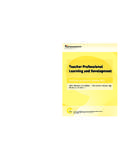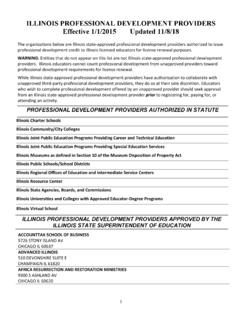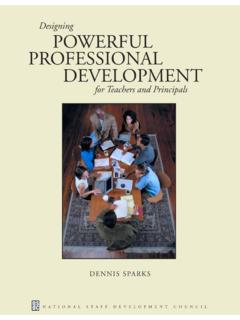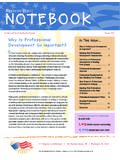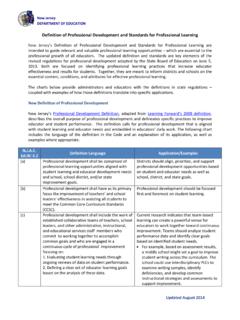Transcription of Planning for Professional Development in Child Care
1 Planning for Professional Development in Child care A Guide to Best Practices and Resources Developed by the North Carolina Institute for Early Childhood Professional Development in cooperation with the North Carolina Division of Child Development and the North Carolina Partnership for Children October, 2001. Contents About the Institute .. 1. Introduction and Acknowledgements .. 2. An Overview of Professional Development .. 4. The Importance of Professional Development .. 4. The Need for Professional Development Systems .. 6. Figure 1: Early Childhood Professional Preparation in North 7. Career Ladders and Career Lattices .. 9. Figure 2: A Sample Career Ladder .. 9. Figure 3: A Sample Career Lattice .. 9. The Importance of Linkages .. 10. The Relationship between Professional Development and Regulation .. 10. Developing an Early Childhood Professional Development Plan .. 12. Figure 4: Flow Chart for Developing a Professional Development 12.
2 Convening a Community Planning Group .. 13. Fostering Collaboration .. 14. Values and Principles .. 14. Ensuring Ongoing Participation .. 15. Community Assessment .. 15. Education and Training .. 16. Systems Coordination .. 16. Financing .. 18. Compensation .. 19. Community Education and Awareness .. 20. Figure 5: Vehicles for Increasing Public Awareness .. 20. Quality Assurance .. 21. Presenting the Assessment .. 22. Identifying Benefits and Barriers .. 22. Figure 6: Benefits of a Professional Development System .. 22. Figure 7: Barriers to a Professional Development System .. 23. Gathering Information About Alternative Strategies .. 23. Creating a Plan .. 24. Developing Goals .. 25. Education and Training .. 25. Compensation 26. Systems Coordination Goals ..26. Consumer and Public Engagement Goals .. 27. Quality Assurance Goals .. 28. Financing Goals .. 28. Developing Objectives.
3 28. Developing Strategies .. 29. Figure 8: A Sample Strategies Matrix .. 30. Planning for Professional Development in Child care Implementing the Professional Development Plan .. 31. Developing An Action Guide .. 31. Including Evaluation In Your Action Guide .. 31. Are We Done Yet?.. 32. Checklist .. 33. Examples of Best Practices Activities .. 36. Goal Area: Education and Training .. 37. Goal Area: Compensation .. 40. Goal Area: Community Education and Awareness .. 42. Goal Area: Quality Assurance Capacity-Building .. 43. Resources .. 44. General Information .. 44. References on Quality .. 44. Systems Coordination 45. References on Compensation .. 45. References on Consumer and Public Engagement .. 46. Useful Web Sites for Child care Professional Development .. 47. Planning for Professional Development in Child care About the Institute The North Carolina Institute for Early Childhood Professional Development was established in 1993 by the North Carolina Division of Child Development (DCD).
4 The Institute is a state- level advisory group of practitioners, agencies and institutions from throughout the state. The Institute is dedicated to defining and advocating for the implementation of a comprehensive early childhood Professional Development system that provides supportive, accessible, and individually appropriate education which is linked to compensation in order to ensure high quality care and education services for children and families. Members of the Institute serve three year terms and include representatives from the following: Child care Providers: teachers, directors and family Child care providers Child care Resource and Referral Service Agencies Head Start (State Collaboration Office and local agencies). Child care Commission Interagency Coordinating Council Division of Mental Health, Developmental Disabilities, and Substance Abuse Services Community Colleges Four Year Institutions of Higher Learning (public and private).
5 North Carolina Cooperative Extension Smart Start (state and local partnerships). Early Childhood Project Division of Public Health Department of Public Instruction Division of Child Development Institute members serve on at least one of the following task groups: Regulations and Programs, Public Awareness, Leadership and Mentoring, Professional Development Infrastructure and Coordination, and Compensation and Education. For more information on the Institute, contact the NCDCD at (919) 662-4499 or visit the website at Planning for Professional Development in Child care 1. Introduction and Acknowledgments This manual was written for those individuals and organizations who are involved in designing, coordinating and promoting Professional Development opportunities for the Child care workforce in their local community. It is particularly designed for use by agencies and individuals participating in Smart Start, especially those working on Professional Development efforts.
6 However, the approach to Professional Development outlined in this manual is based on the research and experience of many states and local communities, and should be useful to non-Smart Start initiatives as well. Smart Start was initiated in 1993 to address the developmental needs of preschool children in North Carolina and to enable local communities to develop innovative and collaborative strategies to ensure their children arrive at school healthy and ready to succeed. Smart Start funds are now available in all 100 counties, yet there is still much work left to be done to meet the needs of working families for high quality early care and education and related services. One of the most important components of providing high-quality early care and education services is Planning for the education and training of staff. This manual is designed to serve as a guide to help local communities in this Planning process.
7 Please note: the Planning process described in this manual is similar to, but not identical to, that required for developing and submitting a Smart Start strategic plan to the North Carolina Partnership for Children (NCPC). Some areas of overlap are noted in this manual. For questions about strategic plans, contact NCPC at (919)821-7999. The manual was developed with the help of Child care professionals from throughout North Carolina and includes: an overview of Professional Development : what it is, how a Professional Development system can help achieve the goal of high-quality Child care , the relationship between Professional Development and licensing requirements and the connection between education, compensation, and the quality of care ;. how to build a Professional Development plan for a local community or region: what to include, and how to guide the Planning process;. examples of plan components.
8 Resources available for use in building a plan. 2 Planning for Professional Development in Child care This manual can be used in a number of ways, depending on your local initiative's activities and how long the collaboration has been in operation. Uses may be: to give collaborators who do not work directly in Child care an overview of the importance of education and training in creating high quality care and education services for children;. to guide a local Professional Development committee in building a plan for its workforce;. to help committees evaluate existing plans and make improvements as needed. The manual contains examples of both best practices in Professional Development and of tools that can be used in the Planning process. Examples are noted by use of the puzzle graphic at left. Acknowledgments Many individuals and organizations have given generously of their time and wisdom to make this publication a reality.
9 An earlier version of the manual authored by members of the Institute provided much of the material, and additional sections were provided by writer/. editor Elizabeth A. Nilsen. Among the many others who deserve heartfelt thanks are the Best Practices Committee and the Public Awareness Task Group of the North Carolina Institute for Early Childhood Professional Development , and reviewers Peggy Ball, Marsha Munn and members of the Executive Committee of the Institute. Note: in this manual the word provider is used to designate all those working in all types of Child care settings, both centers and family Child care homes. Additionally, when the terms Child care or early care and education are used, they are intended to be inclusive of Child care settings serving young children of all ages, from those caring for infants to those serving school-age children. We regret that we have not yet found more precise terminology to reflect the diversity of our communities' programs.
10 Planning for Professional Development in Child care 3. An Overview of Professional Development Professional Development refers to the ongoing, formal preparation that gives Child care staff the knowledge and skills they need to best serve children and families. Well-designed Professional Development includes a broad range of activities and audiences: it benefits providers in all settings, both Child care centers and family Child care homes;. it responds to the needs of providers at all levels, from entry-level assistants to multi-site directors;. it spans a continuum of depth of knowledge, from short-term workshop-style training to college-level education. In this manual, Professional Development will sometimes be referred to as education and training. Education is coursework taken at a college or university. As discussed below, the best quality care is provided by caregivers who have college-level preparation in early care and education.

